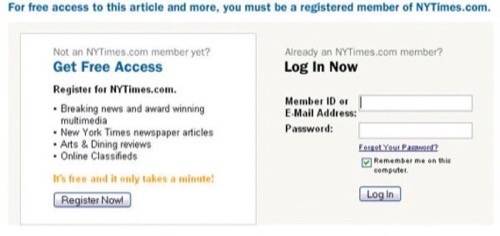A couple of weeks ago, the New York Times removed the pay wall in front of its TimesSelect service, which controlled access to much of the paper’s archives and its popular columnists like Thomas Friedman and Frank Rich. Unfortunately, much of the paper’s non-wire service content still sits behind an utterly useless and annoying registration wall.

The Times says the reason they ask for registration is to be “able to offer people around the world free-of-charge access to news, reviews and more.” But is it really necessary? Can’t they do all those things without annoying users? Do to they get anything out of it? I don’t think so.

I think the New York Times registration system is hurting them for a handful of reasons:
- It’s annoying. On more than one occasion I have simply left the Times site for Google News to find a different source for the news I was trying to access because I couldn’t be bothered by a registration wall. The NYT nixed TimesSelect fees in the hopes of exposing those 787,000 subscribers to advertising — how many more page views would they get if they pulled down the registration wall and fully freed their content?
- It doesn’t get you anything extra. The only incentive to join is that you can read the article you were trying to read in the first place. Instead of a gaining access to a service, the Times makes it feel like you’re being punished.
- Does anyone sign up with real info? Since there is no email verification, there is really no reason for most people to use real information when signing up for the New York Times web site. I would guess that much of the information they capture is fake and thus useless to them. The site is also the most popular on BugMeNot, indicating that there are a number of people fed up enough to only use false info.
So what does the Times get out of all of this? User info that might be helpful for marketing and ad sales if it wasn’t polluted by bogus entries, a few sign ups to their email newsletters (which are opt-in and unchecked by default on the sign up form, so probably not that many), and a bunch of pissed off readers. Is it worth it?
To be fair, the New York Times isn’t the only newspaper that locks content behind a stupid registration wall. The Washington Post, the LA Times, and other major papers have the same annoying habit. There is a simple way for the New York Times to tear down their registration wall and still capture user data and encourage users to sign up for their newsletters.
They can begin by removing registration requirements on all of their content and adding some reason for people to register. The most likely path is to take a page from other news sites and add social features like comments, article rating, and blogs. Not only would the Times only require registration from users who are interested in registering, but they would be capturing information about their most engaged users. The Washington Post is actually halfway there — they already offer a lot of added utility to users who register, but unfortunately, they still require registration simply to view much of their content.










